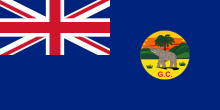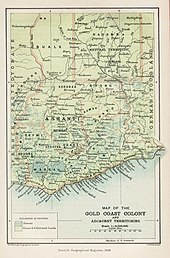Gold coast (colony)
The British crown colony of Gold Coast ( "Gold Coast Colony") in West Africa was from 1878 to 1957 and was part of British West Africa . On March 6, 1957, together with the British protectorate of British Togoland (formerly part of Togoland ), it gained independence as the Republic of Ghana .
The colony comprised the southern parts of today's Ghana and derived its name from the term " gold coast ", which has been used for this stretch of coast since the 17th century . In a broader sense, the term Gold Coast was applied as a political term to the entire British-ruled area of today's Ghana, i.e. from 1900 also to the Ashanti area in central Ghana and the northern areas of today's Ghanaian republic under British rule. The colony covered an area of approx. 187,900 km².
Some sources give the year 1821 as the year of foundation. In that year the British forts on the Gold Coast were placed under the British Colonial Office, but the administration soon passed on to a council of settlers and traders in these forts.
History of the formation of the colony
The Europeans established themselves very early on the Gold Coast, which was made known to Europeans in 1470 by the Portuguese João de Santarém . Diogo de Azambuja landed at Elmina in 1481 with 700 men and built Fort São Jorge da Mina . The Dutch settled in Mori, Ghana (east of Cape Coast Castle ) and other places, and drove the Portuguese out in 1637. English adventurers also settled, but their forts, with the exception of Cape Coast Castle, were taken by the Dutch in 1667. Then in 1672 the Royal African Company of merchants was formed. The company built or reinforced Dixcove , Sekondi , Anomabu , Winneba (Simpah), Accra and Cape Coast Castle, near the Dutch and the previously built Danish forts. From 1683 to 1720 Brandenburg-Prussia gave a brief colonial interlude with the possession of Groß Friedrichsburg . In 1752 a new African company of merchants was formed. Meanwhile, the Fanti took the land of the ruler of Efutu and became allies of the British. The Dutch, on the other hand, allied themselves with the Ashanti . The British and Dutch, including the Danes, paid the chiefs a base rate .
The Ashanti subjugated the land of the Fanti in 1807 and now demanded a land charge from the English. In September 1817 an agreement was finally reached. Then the African Company was abolished in 1821 and the Gold Coast became a dependency of Sierra Leone . The English supported the Fanti and completely defeated the Ashanti army in 1826. However, a treaty was not concluded until 1831, according to which all countries south of the upper Pra were placed under British protection, as was Dankira .
The demand for the establishment of a Gold Coast colony was then increasingly raised by British settlers and local traders from the 1840s. The costs of permanent control of the area seemed to the colonial office in the "motherland" to be too high compared to the possible profit and the request was rejected several times by the responsible authorities. By 1850 the British government, with the exception of a few Dutch settlements, had gradually become the master of the entire Gold Coast.
Nevertheless, several reasons led to the establishment of the colony in 1874:
- In the late 1860s there was a new pro-colonial and pro-imperialist mood in Great Britain against the background of the search for new sales markets and raw material suppliers for domestic industry. In addition, the technical superiority of the Europeans had reached a new quality.
- In 1872 the Dutch were the last European power alongside the British to give up their fortified bases on the Gold Coast in exchange for trade privileges. The successful military resistance of the Fanti Confederation against the takeover of individual British forts (e.g. in Dixcove ) by the Dutch had made a decisive contribution to this . Freed from Dutch competition, the British could count on increased profits in trade and effectively enforce customs revenues.
- In 1874 the Ashanti Empire suffered the decisive defeat against the British. This enabled the British to assert their interests against everyone in what is now Ghana. There was no longer any local power that could do anything to counter them.
The internal conditions in the Gold Coast: Crown Colony, Protectorate and Territory
In July 1874, the "Gold Coast Colony" was founded, which encompassed the entire territory of what is now southern Ghana. This centerpiece of the colony was mostly inhabited by the Fanti. In 1896, as the culmination of a series of armed conflicts, the British occupied Kumasi , the capital of the Ashanti kingdom, captured Asantehene , the ruler of the Ashanti, and declared the Ashanti area a protectorate . Later on, the Mamprusi , Dagomba and other peoples of northern Afghanistan, still known today as the “Northern Territories”, were added.
The form of colonial exercise of power within these three areas was very different. In the “Crown Colony”, the locals were able to exercise political activity in the modern sense of the word to a certain extent: Political associations could be formed without the approval of the British and there was extensive freedom of the press. English law was valid and lawyers were able to combat excesses of colonial rule. In the “Protectorate”, however, lawyers were forbidden from practicing their profession and political associations had to disguise themselves as cultural or social associations. In the crown colony there was also a large number of Western educated Africans who cooperated with the colonial administration and also controlled it to some extent due to the longer British influence. In the “Protectorate”, on the other hand, the British strove to destroy Ashanti-imperialism and its remaining traditions until the 1920s. The “Northern Territories” in turn were not involved in the later attempts at political reform within the Gold Coast. B. no vote in the legislative council of the so-called Burns Constitution of the 1940s.
British exercise of power in the Gold Coast colony: "indirect rule" since the 1920s
Gordon Guggisberg was governor of the colony from 1919 to 1929 and has endeavored to change the existing colonial policy in the Gold Coast since taking office. His model was the theories of indirect rule of the then governor of British Nigeria , Lugard .
In brief, this theory provided for the most comprehensive possible delegation of administrative tasks to the local elites and traditional heads of the colonies - but only at the lower administrative levels. Actually influential posts were reserved for the British, even according to the theory of "indirect rule". Nevertheless, this form of administration certainly promoted the emergence of an elite educated to the west and a civil society, especially in the south of the country.
The Road to Gold Coast Independence
Throughout their rule, the British faced various forms of resistance on the Gold Coast. From resistance to the introduction of a poll tax in the 1860s or the armed uprising of the Ashanti around 1900 to the youth movement of the 30s and economic boycott movements in the 40s. For Ghana, colonization was not all bad, because the standard of living improved significantly after cocoa cultivation began at the beginning of the 20th century. Something similar can be seen after the Second World War. Overall, Ghana has better living standards at these times than during the period after independence.
In 1947, the United Gold Coast Convention Party was founded, a party that had the country's independence as its program. At the forefront was the later founding president and national hero of Ghana, Kwame Nkrumah . The party took an enormous boost from the so-called Accra riots . These “Accra riots” broke out in Accra in 1948 after the deaths of two demonstrators by British police bullets, and soon spread to different parts of the country, killing 29. In the wake of the unrest, a number of party leaders were arrested, including Kwame Nkrumah.
In 1949 the nationally already hugely popular Nkrumah founded a new party, the Convention People's Party , which represented the demand for independence in a much more radical way. In the 1950 elections, Nkrumah's CPP won almost nationwide.
In 1951, the colonial administration had to release Nkrumah, who had meanwhile been re-imprisoned, from prison and entrust him with the post of "head of government". During the reign of his party from 1951 to 1954, under British rule, there were extraordinary advances in the infrastructure of the Gold Coast in the areas of transport and education, so that the CPP again won significantly in the next elections, despite the now grown regional, political competition in the Ashanti area . On March 6, 1957, the history of the British Gold Coast colony ended with the establishment of independent Ghana .
See also
literature
- Wilhelm Bosmann : Reyse to Guinea or detailed description of the gold pits / elephant teeth and slave trade / along with their inhabitants customs / religion / regiment / wars / heyraths and burials / also all animals located here / so previously unknown in Europe ( Naauwkeurige beschryving van de Guinese Goud Tand en Slawenkust). Heyl & Liebezeit, Hamburg 1708.
- Wilhelm Crecelius : Josua Ulsheimer's travels to Guinea and description of the country . In: Allemannia (Bonn) , Volume 7 (1879), pp. 97-120.
- James B. Webster, Albert Adu Boahen : The Revolutionary Years. West Africa since 1800. Longman, London 1984, ISBN 0-582-60332-3 .
Individual evidence
- ↑ a b c Baten Jörg, Austin Gareth, Moradi Alexander: Exploring the evolution of living standards in Ghana, 1880-2000: An anthropometric approach . January 1, 2007 ( researchgate.net ).


